
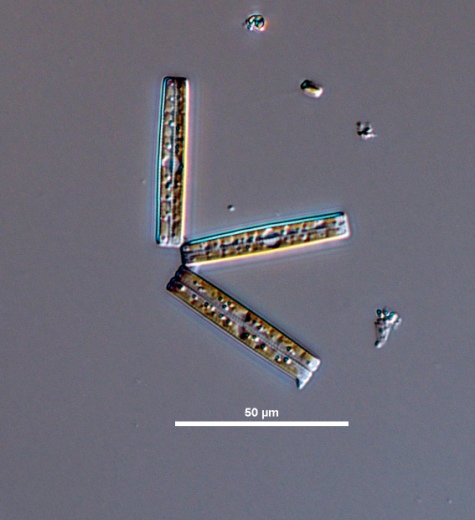
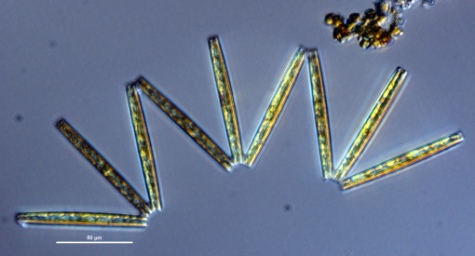
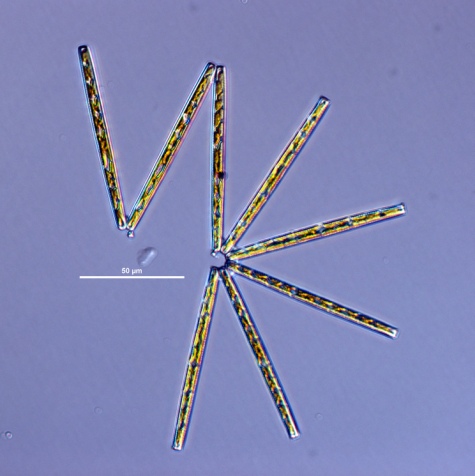
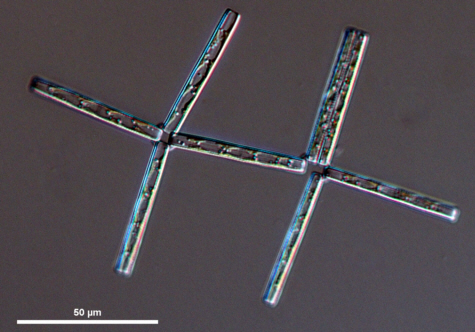
|
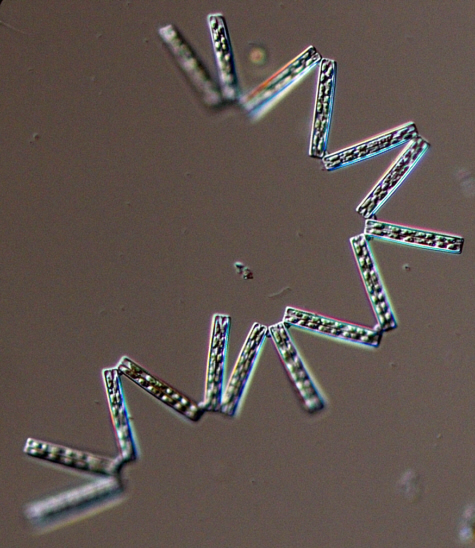
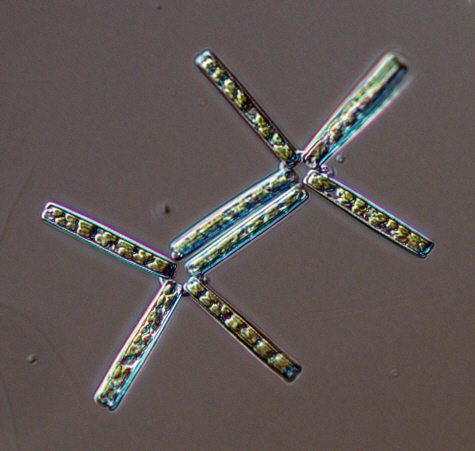


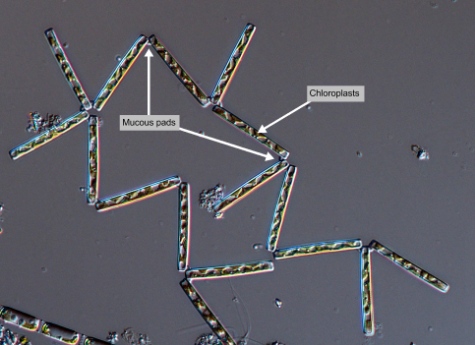
|
Synonym(s)
Homotypic
Expressing the same fundamental type or structure; may or may not be symmetrical (e.g., the two valves of a diatom, where they are the same shape and appearance, but one is bigger than the other). In naming species, a homotypic synonym is one that comes into being when a taxon gets a new name (without being added to an already existing taxon).
(homotypic)Thalassionema nitzschioides (Grunow) Van Heurck 1896 (homotypic)
Thalassiothrix curvata Castracane 1886 Close
Heterotypic
A difference in type. In naming species, a heterotypic synonym is one that comes into being when a taxon becomes part of a different taxon. Compare to homotypic.
(heterotypic)Synedra nitzschioides var. minor Cleve 1883 (heterotypic)
Thalassiothrix nitzschioides var. javanica Grunow (heterotypic)
Thalassiothrix nitzschioides (Grunow) Grunow 1881 (homotypic)
Synedra nitzschioides Grunow 1862 Close
Basionym
The original name for an organism. In botany, the original published nomenclature from which a new binomial nomenclature is derived for a particular group of organisms (Tindall 1999).
(basionym, homotypic)(Guiry and Guiry 2011)
Classification
(Guiry and Guiry 2011)
Lifestyle
Description
Valve
In diatoms, the structurally distinct halves of the cell wall (Becker 1996).
valves. Cells are rectangular in CloseGirdle
In diatoms, the portion of the cell wall between the two valves of a cell; made up of intercalary bands (bands closest to the valves) and connecting bands (bands in the middle of the girdle). In dinoflagellates, the equivalent of a cingulum or transverse furrow (Horner 2002).
girdle view, with valve ends that are similar in shape and width, and are narrowly elliptical in valve view. Chloroplasts are small and numerous (Kraberg et al. 2010). Cells are yellow-brown in colour (Guiry 2011).Labiate process
In diatoms, a simple slit in the valve wall with two internal lips, one on each side of the slit. They can be useful in identification because they are positioned differently in different species (Horner 2002).
labiate processes, one on each end; a small CloseApical
(axis, spine) The region of the apex or point. Refers to the most anterior point or region of the cell (HPP 2003).
apical CloseSpine
In some diatoms, "closed or solid structures projecting from the cell wall;" in dinoflagellates, solid projections that usually taper to a point.
spine is sometimes also present (Kraberg et al. 2010). CloseMargin
The outline or border that defines the shape of an organism or cell.
"Marginal CloseAreola(e)
In diatoms, the regularly repeated hexagonal holes on the valve walls (HPP 2003).
areolae are visible as CloseRibs
Features that provide support to other structures in the cell.
ribs with CloseLM
(light microscopy) "Using a microscope in which a beam of light passes through optical lenses to view an image of the specimen" (MCM LTER 2010).
LM. The CloseSternum
In pennate diatoms, the thickened silica structure that usually extends along the apical axis and may be centrally or marginally positioned. In diatoms with raphes, the sternum contains the raphe (Spaulding et al. 2010).
sternum is broad and without areolae. Internally, each valve pole has a simple, slit-like labiate process, which appears externally as a small, round hole (visible with CloseSEM
(scanning electron microscope) A microscope which applies "a focused beam of high-energy electrons to generate a variety of signals at the surface of solid specimens" (NSF 2011).
SEM)" (Horner 2002).Measurements
Width Close
Transapical axis
In diatoms, the longitudinal axis of the valve.
(transapical axis): 2 - 4 μmHeight Close
Pervalvar axis
The axis through the centre point of the two valves of a frustule. This axis is perpendicular to the valve face.
(pervalvar axis): 3 - 8 μmMarginal areolae: 10 - 12 in 10 μm
(Cupp 1943, Kraberg et al. 2010)
Similar species
Harmful effects
Habitat
Distribution
Cosmopolitan except in polar regions (Hasle and Syvertsen 1997).
Blooms in late summer to fall in the coastal inlets of BC (Hay 2003). In spring and summer months in Norwegian waters (Degerlund 2010). In the summer months in India (Thillai Rajasekar et al. 2010). Most abundant in spring in Northern European seas (Kraberg et al. 2010).
"North temperate species. Very common and often abundant off southern California and Lower California, in the Gulf of California, and north to Scotch Cap, Alaska" (Cupp 1943).
Growth conditions
Nutrients
Various chemical substances that an organism needs for metabolism (i.e., to live and grow). These are usually taken up from the environment. Some examples include nitrate, phosphate, silica (for diatoms), iron, copper, etc. Some nutrients, like copper, are required for growth, but can also be toxic at high levels.
nutrient-rich CloseUpwelling
A wind-driven mechanism of mixing the water column. Cold, dense, nutrient-rich, and often oxygen-poor water from depths rises to replace the warmer nutrient-poor surface water. This input of nutrients can have a significantly increase primary productivity in a region (Dugdale 1985).
upwelling regions (Abrantes 1988, cited in Kobayashi and Takahashi 2002). Its presence indicates conditions of high productivity (Schrader and Sorknes 1990, cited in Kobayashi and Takahashi 2002). Optimal temperature ∼15 °C (Resende 2007). Salinity range from ∼12 - 33 (Demir 2007, Burns 1977).Environmental Ranges
Temperature range (°C): -1.938 - 29.468
Nitrate (μmol L-1): 0.053 - 33.849
Salinity: up to 37.775
Oxygen (mL L-1): 3.946 - 9.143
Phosphate (μmol L-1): 0.046 - 2.366
Close
Silicic acid
A general term to describe chemical compounds containing silicon, oxygen and hydrogen with a general formula of [SiOx(OH)4-2x]n. Diatoms polymerize silicic acid into biogenic silica to form their frustules (Azam and Chisholm 1976).
Silicate (μmol L-1): 0.648 - 116.089(OBIS 2011, cited in EOL 2011)
Bloom characteristics
References
Abrantes, F. 1988. Diatom assemblages as upwelling indicators in surface sediments off Portugal. Marine Geology. 85: 15-39.
Burns, D. A. 1977. Distribution of Planktonic diatoms in Pelorus Sound, South Island, New Zealand. New Zealand Journal of Marine and Freshwater Research. 11(2): 275-295.
Chen, Y. L. L. 1995. Phytoplankton composition and productivity in response to the upwelling off northeastern Taiwan. Proceedings of the National Science Council, Republic of China, Part B: Life Sciences. 19(1): 66-72.
Cupp, E. E. 1943. Marine Plankton Diatoms of the West Coast of North America. University of California Press. Berkeley, California. 238.
Degerlund, M. and Eilertsen, H. C. 2010. Main Species Characteristics of Phytoplankton Spring Blooms in NE Atlantic and Arctic Waters (68 - 80 °N). Estuaries and coasts. 33(2): 242-269.
Demir, N. 2007. Changes in the phytoplankton community of a coastal, hyposaline lake in western Anatolia, Turkey. Limnology. 8(3): 337-342.
Encyclopedia of Life. 2010. Thalassionema nitzschioides (Grunow) Grunow ex Hustedt. http://www.eol.org/pages/910371. Accessed 10 Jun 2011.
Guiry, M. D. 2011. Thalassionema nitzschioides (Grunow) Mereschkowsky, 1902. http://www.marinespecies.org/aphia.php?p=taxdetails&id=149093. Accessed 05 May 2011.
Guiry, M. D. and Guiry, G. M. 2011. Thalassionema nitzschioides (Grunow) Mereschkowsky, 1902. AlgaeBase. National University of Ireland, Galway. http://www.algaebase.org. Accessed 02 June 2011.
Hasle, G. R. 2001. The marine, planktonic diatom family Thalassionemataceae: Morphology, taxonomy and distribution. Diatom Research. 16: 1-82.
Hasle, G. R. and Syvertsen, E. E. 1997. Marine diatoms. In: Tomas, C. R. (ed.) Identifying Marine Phytoplankton. Academic Press, Inc., San Diego. 5-385.
Hay, M. B., Pienitz, R. and Thomson, R. E. 2003. Distribution of diatom surface sediment assemblages within Effingham Inlet, a temperate fjord on the west coast of Vancouver Island (Canada). Marine micropaleontology. 48(3-4): 291-320.
Horner, R. A. 2002. A Taxonomic Guide To Some Common Phytoplankton. Biopress Limited, Dorset Press, Dorchester, UK. 200.
Kraberg, A., Baumann, M. and Durselen, C. D. 2010. Coastal Phytoplankton: Photo Guide for Northern European Seas. Verlag Dr. Friedrich Pfeil, Munchen, Germany. 204.
Kobayashi, F. and Takahashi K. 2002. Distribution of diatoms along the equatorial transect in the western and central Pacific during the 1999 La Niña conditions. Deep Sea Research Part II: Topical Studies in Oceanography. 49(13-14): 2801-2821.
Ocean Biogeographic Information System. Thalassionema nitzschioides. http://www.iobis.org/mapper/?taxon_id=518555. Accessed 10 Jun 2011.
Resende, P., Azeiteiro, U. M., Goncalves, F. and Pereira, M. J. 2007. Distribution and ecological preferences of diatoms and dinoflagellates in the west Iberian Coastal zone (North Portugal). Acta Oecologica. 32(2): 224-235.
Romero, O. E., Rixen, T. and Herunadi, B. 2009. Effects of hydrographic and climatic forcing on diatom production and export in the tropical southeastern Indian Ocean. Marine Ecology Progress Series. 384: 69-82.
Schrader, H. and Sorknes, R. 1990. Spatial and temporal variation of Peruvian coastal upwelling during the last Quaternary. Proceedings of the Ocean Drilling Program, Scientific Results. 112: 391-406.
Thillai Rajasekar, K., Rajkumar, M., Sun, J., Ashok Prabu, V. and Perumal, P. 2010. Bloom forming species of phytoplankton in two coastal waters in the Southeast coast of India. Journal of Ocean University of China. 9(3): 265-272.
